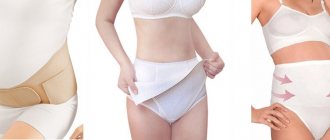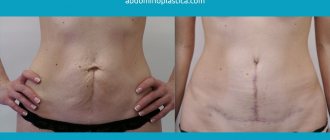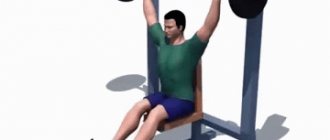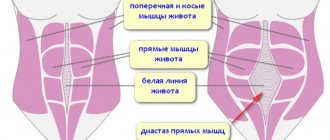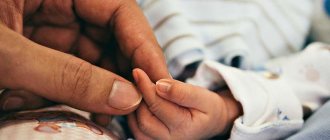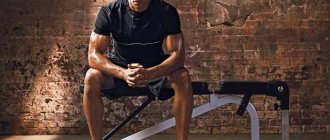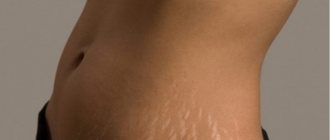Beautiful female belly with a hollow in the middle
Diastasis (from Greek diastosis) is separation, stretching, thinning, interval. We will talk about the divergence of the linea alba, which connects the rectus abdominis muscles.
The linea alba is not a muscle
. This is connective tissue, which consists of dense collagen and elastic fibers.
Normal (left) and overstretched linea alba
Normally, in women and men, the width of the white line is 0.5 - 3 cm. Anything more is classified as diastasis of the rectus abdominis muscles, that is, an increase in the distance between the left and right rectus muscles.
The divergence of the rectus abdominis muscles is essentially reminiscent of a seam on clothing. If the seams separate, the parts no longer fit tightly together. The same thing happens to the linea alba when the collagen stretches.
Contrary to claims about the benefits of exercise, diastasis does not go away on its own. Only surgery can help cope with this condition.
We at Platinental eliminate diastasis using a unique technique that has no analogues in Russian surgical practice.
What is the difference?
- We perform surgical treatment of diastasis of the rectus abdominis muscles without incisions, using endoscopic access,
- if it is necessary to remove excess skin, we perform the procedure through a small 4-centimeter incision below the bikini line; carefully mask the seam,
- we form a beautiful and flat stomach with abs; We emphasize the female belly with a small vertical hollow in the middle.
- We know how to bypass the temporary difficulty in breathing that is typical for such operations, and thereby speed up the recovery period.
From this article you will learn how to independently understand whether there is diastasis of the white line of the abdomen, why diastasis is dangerous and why it cannot be cured at home.
First, we will talk about diastasis itself and the health risks associated with it. Then we will introduce you to the latest surgical practices for suturing diastasis of the rectus abdominis muscles and its aesthetic correction.
Reliable signs of diastasis
Diastasis has one peculiarity. Even if you have a pumped-up and flat stomach, literally half a mug of water radically changes the situation, and your stomach looks like it would if someone was never friendly with sports. The anterior abdominal wall protrudes, the navel falls out.
The appearance of the abdomen is determined by the location and degree of diastasis: in some it manifests itself as a “bloated” abdomen, in others – an inverted navel.
Diastasis is dangerous due to its consequences
Usually people come to surgeons with a complaint about an unsightly “pregnant” or “beer” belly. But diastasis is dangerous not because of aesthetics, but because of its health consequences.
Sooner or later, diastasis will be joined by an abdominal hernia, when fat or a small fragment of intestine comes out between the stretched fibers of the linea alba. A hernia is formed if you torment yourself with loads and intense training: pumping up your abs, doing squats, lifting weights.
A hernia with diastasis is a time bomb that carries the risk of strangulation and necrosis. Any necrosis is treated by emergency removal of the strangulated area, and in the case of the intestines causes lifelong problems.
The mechanism of formation of abdominal hernia.
A second pregnancy with diastasis of the abdominal muscles carries the risk of oxygen starvation in the child and weak labor.
The disease manifests itself not only externally. Due to changes in the anatomy of the abdominal cavity, organs are displaced and their activity is disrupted. Therefore, the presence of diastasis is usually accompanied by numerous digestive disorders from the intestines - spasms, lower back pain, bloating, flatulence, constipation, a feeling of fullness in the abdomen. Over time, these symptoms intensify and include urinary incontinence.
How to determine abdominal diastasis yourself
To check your stomach yourself and recognize diastasis, you need to lie on a flat surface and bend your knees. Place one hand behind your head. Then as you exhale
lift your upper body as if doing abs. This makes it easier to detect the boundaries of the rectus abdominis muscles. With your other hand, feel the middle of your stomach, between the abdominal muscles. Diastasis is felt especially well in the navel area, since anatomically the white line of the abdomen is wider in this place.
And don’t be alarmed when you find a discrepancy - if the distance between the muscles does not exceed 3 centimeters, everything is fine. More means you need to schedule an appointment with your surgeon. You decide for yourself whether to have surgery or not, but it is necessary to make a diagnosis.
On the left is diastasis of the white line of the abdomen, on the right is a normal, healthy abdomen.
How to remove diastasis without surgery? Will exercise help with abdominal muscle diastasis?
If more than 6 months have passed since birth, it is impossible to remove the belly with diastasis without surgical intervention. Neither the plank, nor the vacuum, nor massage will reduce it. No matter what you do, this condition will not go away on its own, and will only get worse over time.
Expert comment:
“Exercise does not help eliminate diastasis. Sports train muscles; the connective tissue of the white line of the abdomen is not a muscle.
However, uniform and moderate tension of the white line of the abdomen during exercise contributes to a slight renewal of connective tissue and its reduction. But not so significant as to “close” the diastasis. But intense workouts have the opposite effect - they increase intra-abdominal pressure, which continues to stretch the linea alba even more.
It is strictly forbidden to do strength exercises with diastasis of the rectus abdominis muscles after cesarean section. In this case, there is also the risk of seams coming apart.”
Vladislava Gladysheva, plastic surgeon.
When is it okay to start removing the belly after a caesarean section?
After a natural birth, light exercise can be done within a month. After a caesarean section, you should wait at least 2-3 months before starting to exercise. Only after 6-7 months can the doctor allow you to start doing abdominal and waist exercises, provided that the recovery stage has been successful.
Immediately after surgery, begin wearing a postpartum brace. It will help you recover faster and tighten your tummy. Be sure to adjust your diet, drink more water, and walk in the fresh air. Even if physical activity is prohibited, you can lead a healthy lifestyle in order to quickly regain your former slimness.
Does diastasis occur in men?
Often, the discrepancy of the abdominal muscles in men is caused by excessive physical activity or, conversely, the lack thereof.
In the first case, overload leads to an increase in intra-abdominal pressure. In the second - to weakness of the abdominal muscles, due to which they cease to “hold” the internal organs, the white line experiences increased tension and gradually stretches.
Excess weight and the so-called “beer belly” lead to the development of diastasis of the rectus abdominis muscles in men. This is why the tummy does not go away even after lifestyle changes and total weight loss: an overstretched linea alba does not allow the abdominal muscles to hold the internal organs.
Treatment of abdominal muscle diastasis in men requires surgical suturing of the defect.
The Importance of Physical Therapists
Friends, this and other issues will be discussed at Marina Osokina’s seminar “Women’s health: opportunities for restorative fitness and physical therapy.” Find out more...
Pelvic floor restoration
Women who give birth by cesarean section may need to restore the function of their pelvic floor muscles. Many women go through a long labor process before deciding to have a caesarean section. Thus, the pelvic floor muscles, pudendal nerves, and nerves supplying the anal muscles may be damaged. In addition, pregnancy itself places significant pressure on the pelvic floor muscles and other soft tissues.
Postoperative rehabilitation
Therapeutic measures in the postpartum period for women who gave birth by cesarean section are the same as for women who gave birth through the birth canal. However, a caesarean section is considered a major abdominal operation with all the ensuing consequences and, thus, the woman will require general post-operative rehabilitation.
Physical therapy
Goal: Improve pulmonary function and reduce the risk of pneumonia
- Instructions on proper breathing should be given.
- The patient should be taught coughing and/or forced exhalation techniques with the head open.
Goal: Reduce postoperative pain that occurs during coughing, movement, or breastfeeding.
- Carrying out electrical neurostimulation.
- Support the incision site with a pillow during coughing and breastfeeding.
- Support the incision site with pillows or hands when moving, teach how to care for the incision site, and educate about the risks of injury.
Goal: To prevent postoperative vascular or gastrointestinal complications.
- The patient must be taught active exercises that involve the legs.
- Early ambulation should be encouraged.
- The patient can be trained to perform abdominal massage to improve peristalsis.
Goal: Improve blood circulation at the incision site and its healing; prevent scar formation.
- The patient should be taught gentle exercises targeting the abdominal muscles while supporting the incision site.
- Scar mobilization may be performed.
- Friction massage can be performed.
Goal: Reduce postoperative discomfort from flatulence, scratching, or catheterization.
- Instructions for correct positioning must be given.
- Massage may be provided.
- The patient can be taught to do maintenance exercises.
Goal: Correct posture.
- Instructions should be given to maintain correct posture, especially when caring for a child.
Goal: Prevent injury and reduce low back pain.
- Instructions should be given regarding bracing the incision site and positioning during daily activities.
- Instructions must be given on how the body moves.
Goal: Prevent pelvic floor dysfunction.
- The patient must be taught pelvic floor exercises.
- The patient should be made aware of the risk factors and types of pelvic floor dysfunction.
Goal: Develop strength in the abdominal wall.
- The patient must be taught to perform a series of abdominal wall exercises, including corrective exercises for diastasis recti.
Diastasis during pregnancy
Diastasis of the rectus abdominis muscles after childbirth develops for several reasons.
On the one hand, during pregnancy the pregnant uterus presses on the linea alba from the inside. On the other hand, the female body is preparing for childbirth. It produces special hormones that increase tissue elasticity. But as a side effect, we observe softening and divergence of the white line of the abdomen.
An effective way to prevent diastasis during pregnancy is sports. The only condition: you need to start doing exercises at least a year before pregnancy, so that the muscles of the anterior abdominal wall have time to get stronger and prevent the white line of the abdomen from spreading. It is necessary to pay attention to physical exercises during pregnancy - naturally, if the condition allows.
To prevent diastasis during pregnancy, many women use a bandage as a preventative measure. It cannot be said that it will 100% avoid problems, but it will relieve the load on the anterior abdominal wall. The main thing is to choose the right size, only after consulting a doctor, and wear it for no more than 3-4 hours at a time.
However, diastasis of the abdominal muscles after the first pregnancy is observed much less frequently than after the second. Therefore, planning a second child needs to be approached especially thoroughly.
True and false abdominal diastasis after childbirth
Not every pregnancy requires treatment for abdominal diastasis after childbirth. Take your time immediately after giving birth to look for signs of diastasis and make a diagnosis for yourself.
After childbirth, the body is still focused on recovery. Everything that is softened and stretched tends to contract, and the stomach gradually returns to normal. Therefore, it is premature to suspect muscle diastasis immediately after the birth of a child. The body comes to its senses gradually, and it is quite possible that a soft stomach is a temporary phenomenon that will pass on its own.
It makes sense to help yourself avoid diastasis of the abdominal muscles after childbirth with the help of a corset and a fitness instructor. And don't delay! Only in the first months after childbirth can you do without surgery and significantly reduce the initial stages of diastasis.
A year after giving birth it will be too late, and no home methods will give results.
Why does the abdomen take longer to retract after a cesarean section?
Throughout the pregnancy, the belly slowly stretched and immediately after giving birth it looked like a deflated ball. But nature itself took care of how to remove the belly and sides after childbirth. Under the influence of hormones that are released in huge quantities during childbirth, the abdominal muscles begin to noticeably contract. And thus the stomach should gradually return to its prenatal state. But if delivery took place by caesarean section, then this is a little unnatural for the body and the hormonal processes intended by nature will not proceed quite correctly.
A caesarean section is the removal of the fetus from the mother's body through a surgical incision in the uterus. This operation is performed when it is impossible to give birth naturally. In order to get to the uterus, it is necessary to cut through several layers, including the abdominal muscles. And during the period when the muscles are supposed to contract, they are injured and grow together. This may be aggravated by the following:
- low skin elasticity due to vitamin deficiency or slow metabolism
- significant weight gain during pregnancy
- weak muscle corset
- diastasis
You can pump up your abs after a cesarean section no sooner than 4 months later.
But is it possible to remove the belly after a caesarean section? It’s possible, it’s not a death sentence, but you’ll have to try a little.
Surgery for diastasis of the rectus abdominis muscles
An incision cannot be avoided if hernioplasty is necessary - surgery to remove diastasis and umbilical hernia, or abdominoplasty - removal of excess skin.
To carry out this procedure, we make a very small incision of 4-5 centimeters in the lower abdomen below the bikini line. It gives the surgeon freedom not only to remove hernias, but also to create a beautiful abdomen.
Expert comment:
“Despite the presence of a stitch, this is a very rewarding operation.
It allows not only crosslinking of diastase. This technique allows you to perform aesthetic abdominoplasty - remove excess skin, perform laser liposuction and remove fat, eliminate sagging abdomen and stretch marks, make the stomach flat, change the shape and position of the navel, emphasize the abdominal muscles and create the relief of a sports abdomen.
During the operation, I can create a sexy cleavage from the sternum to the navel, which looks very feminine. Or you can put special sutures on excessively wide muscles, limit the amplitude of their movement and form a pronounced waist.
The fat obtained during liposuction can be used as part of the same operation for liposculpture of the buttocks.
I make the cut in such a way that the seam can be covered with the smallest bikini. A special suturing technique reduces the time of surgery and rehabilitation, and makes scars and scratches almost invisible.”
Vladislava Gladysheva, plastic surgeon.
Typically, tummy tuck leads to breathing difficulties: the diastasis is stitched, and a feeling of a narrow corset appears in the abdominal area.
Over time, the body gets used to this condition, but the lack of oxygen affects both the general condition and recovery time. This is called compartment syndrome, or compartment syndrome. Before the operation, we carry out special, easy preparation, which almost completely eliminates the occurrence of compartment syndrome and ensures a quick and comfortable recovery after the procedure.
How to remove belly fat at home after caesarean section
Most of all, in terms of figure, women after a caesarean section are concerned about how to remove the belly and the folds on it. There are basically no exercises for getting rid of fat in a specific area of the body. But the abdominal muscles can be pumped up, then the stomach will be more toned and the waist will look sleeker. Since the woman who underwent a cesarean section is a young mother, she does not always have the opportunity to go to the gym. That is why she is interested in how to remove belly fat after a caesarean section at home.
If the doctor has given the go-ahead for the exercises, then you can do them at home, because they don’t require anything other than 30 free minutes a day. Exercises after cesarean are done without the use of additional weight, and all movements are very smooth.
The plank exercise works all the muscles of the body
- The plank is done simply, you need to hold your body in weight, leaning only on your elbows, at an angle of 90 degrees and toes. You need to stay in this position for as long as possible. Despite the simplicity of the technique, it is quite difficult to do this for a long time. But the exercise is very effective, and when performed regularly, it strengthens many muscle groups, including the abdominal muscles. It is best to do it in the morning, before breakfast. If the exercise begins to be easy, then you can complicate it: perform it on your side or stretch one arm forward.
- Leg swings Done from a supine position. The body is pressed to the floor, one by one swinging upwards with straight legs. If the exercise is performed correctly, the abs will noticeably tighten. It is recommended to perform 4-5 approaches of 12-20 times.
- Riding a bicycle To remove belly fat after a caesarean section, you can ride a bicycle for half an hour a day. The main thing is not to overdo it, even if before giving birth you could easily drive 5 km without rest. Start to increase the distance gradually, do not pick up speed, drive on a flat surface. If you don’t have a bicycle, it doesn’t matter, you can get out of the situation. At home, lying on the bed in the “birch” position, imitate riding a bicycle. The abdominal muscles become noticeably tense from this exercise.
- The “vacuum” exercise is done exclusively on an empty stomach. You need to stand with your body tilted forward and lean against something stable, such as a windowsill or sink. Exhale all the air from your lungs at once, and then sharply draw in your stomach strongly, imagining how the walls of your stomach are in contact with your spine. Hold this for at least 10 seconds, increasing over time to 30 seconds. Relax and repeat. It is recommended to do 2-3 approaches of 10-12 times. Video lesson “Technique for performing the vacuum exercise” This exercise is borrowed from yoga practices and is very useful for strengthening all abdominal muscles and massaging internal organs. Experienced yogis are able to move their abdominal muscles very actively, releasing waves. Normal exercise should not cause pain.
- Water aerobics and swimming Exercises in water are very gentle. You can start with freestyle swimming, and then move on to group or individual exercises with a coach. But the coach must be aware of the previous operations. In water, body weight is felt less and the load on the spine is minimal. With lower loads, exercises to strengthen the muscle corset will be more effective. The movements themselves in the water are already a small massage that increases blood circulation, which is so necessary to restore skin elasticity.
After operation
Rehabilitation after suturing of diastasis depends on the volume of intervention and requires from 1 to 4 weeks. You will need to wear surgical underwear for a month.
Endoscopic surgery involves discharge the next day.
After abdominal surgery, you need to spend a day in the hospital. You can get up and walk on the day of surgery. The stitches are removed on the 8th day. After 14 days, physical activity is allowed. After a month, you can return to your normal lifestyle.
Suturing of diastasis recti in 99% of people lasts a lifetime. The operation is not a contraindication to planning a pregnancy.
How to recover after a cesarean section
According to statistics, in our time, for every 6-8 women in labor, one has a caesarean section. The operation involves removing the baby from the uterus through a previously made incision in the abdominal cavity.
The recovery process after a cesarean section is quite difficult and lengthy when compared to a vaginal birth. We suggest you figure out what complications may arise, how to eat, whether you can play sports, and how to remove the belly after a caesarean section.
Today, a caesarean section is not a novelty and is perceived by many as some kind of simple manipulation that does not require special attention. But be that as it may, it refers to abdominal surgery, is performed under general or spinal anesthesia and requires special measures to restore the body. Like any operation, a cesarean section can be accompanied by risks and complications.
Complications after caesarean section
The most common complications after a cesarean section are related to both the abdominal cavity and the woman’s body as a whole. The most common of them are:
- Significant blood loss. So, if during a natural birth about 250 ml of blood is lost, then during an operative birth - from half a liter to a liter. Therefore, sometimes women after a cesarean section require a blood transfusion to restore normal hematopoiesis;
- Intestinal adhesions. With minor adhesions, a woman may not feel much discomfort, but more pronounced ones also occur, in which problems with digestion, stool, and pain in the abdomen arise;
- The occurrence of an inflammatory process of the uterine mucosa - endometritis;
- Disorders of uterine contractions due to mechanical effects on it. To prevent such a complication after a cesarean section, special therapy is carried out, the purpose of which is to improve the contractile activity of the uterus.
The listed complications are not a pattern, but can occur. It all depends on the state of health of the woman in labor, her compliance with medical recommendations and the competence of the attending doctor.
What should nutrition be like after a caesarean section?
As after any abdominal surgery, nutrition after a cesarean section involves a number of restrictions. During the first 24 hours after surgical delivery, the patient is allowed to drink only unsweetened tea or still water. On the second day, you can introduce chicken broth, pureed dishes, lean meat chopped in a blender, and cottage cheese into the diet.
The transition to the regular menu of a woman who has given birth should be carried out gradually, enriching it with foods rich in vitamins, proteins and microelements. But we must not forget that nutrition after a cesarean section should also be limited to a diet intended for women during lactation. And she excludes foods that can cause allergies or intestinal colic in a breastfed baby.
Suture after caesarean section
The C-section scar will bother you for a while and will stay with you for life. Unpleasant painful sensations in the area where the scar formed after a cesarean section (a forum on this topic can be found on our website) can be observed for six months, and sometimes even a year. The reason for this is a violation of the integrity of the nerve endings, which need a long time to recover.
A special bandage will partially help to remove the belly after a caesarean section. But you can wear it only as prescribed by your doctor and not all the time, because the abdominal muscles must independently restore their tone.
Sports after cesarean section, aimed at strengthening the abdominal press, are allowed no earlier than one and a half to two months after the birth of the child. But be aware that excessive exercise after a cesarean section can lead to deformation in the scar area and even the formation of a hernia. It should be noted that the less subcutaneous fat a woman has and the more developed her abdominal muscles are, the better and faster the postoperative wound heals. Various cosmetics for resolving scars are not prohibited, although they have little effect.
How quickly the suture heals after a cesarean section also depends on the lifestyle the woman leads. The help of relatives is very important during the recovery period after surgical childbirth. It is advisable that in the first weeks someone should be constantly with the woman and help her with housework. Indeed, for the speedy restoration of the normal state of the mother’s body and high-quality lactation, proper rest is very important. And a woman cannot lift weights after surgical childbirth. Doctors recommend that after a cesarean section, during the first few months, you should not handle anything that exceeds the baby’s weight.
Sex after cesarean: when is it possible?
There is no clear answer to the question of when sex is allowed after a caesarean section. Some experts say two weeks after surgery, others say a month and a half, and some say it’s worth waiting as long as three months. Everything is individual, therefore, in such an intimate matter, you need to listen, first of all, to your body: how the scar heals after a caesarean section, does it hurt, is there any pain in the abdomen.
Understanding your partner is very important at this time. After all, sex often comes last for a woman who has recently given birth. Due to the inevitable lack of sleep and hormonal changes, the mother's body is weakened and not ready for sexual activity.
When resuming sexual relations, do not forget about contraception. Indeed, even during the lactation period, when menstruation has not yet resumed after a cesarean section, a woman can still become pregnant. And in the case of surgical childbirth, the next pregnancy is recommended only after 2-3 years. An abortion in the postoperative uterus can lead to infertility in the future.
Recovery after a cesarean section will occur without complications if the woman follows the gynecologist’s recommendations and takes care of herself.
C-section

